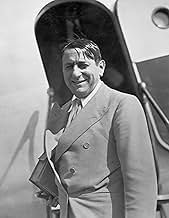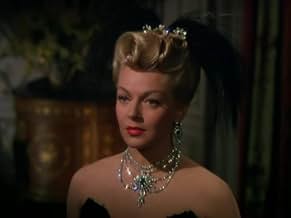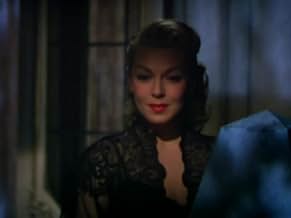IMDb RATING
5.7/10
704
YOUR RATING
Operating under royal orders, a count must woo a young and wealthy widow in order to save a kingdom from bankruptcy.Operating under royal orders, a count must woo a young and wealthy widow in order to save a kingdom from bankruptcy.Operating under royal orders, a count must woo a young and wealthy widow in order to save a kingdom from bankruptcy.
- Nominated for 2 Oscars
- 2 nominations total
Sujata Rubener
- Gypsy Girl
- (as Sujata)
Ludwig Stössel
- Major Domo
- (as Ludwig Stossel)
John Alban
- Club Patron
- (uncredited)
Erville Alderson
- Cart Driver
- (uncredited)
Bette Arlen
- Girl at Maxim's
- (uncredited)
Frank Arnold
- Waiter
- (uncredited)
Gertrude Astor
- Reception Guest
- (uncredited)
Featured reviews
My wife and I met doing a professional production of "The Merry Widow" in 1982 -- in English, but a straight translation.
Only the very basic skeleton of the original plot is visible in this "adaptation". Most of the characters have been deleted, along with the entire B plot, and all but one of the characters remaining have been renamed. Most of the characters in the movie aren't in the operetta, either. The action has been moved from Paris to, at first, Washington, DC, and then to the fictional country of Pontevedro, which the movie has renamed "Marshovia", and only later to Paris. The net result is that we don't reach the beginning of the original play until about 45 minutes in.
And the main source of tension in the plot is deleted, too. In the original, years before, Count Danilo and the heroine were very much in love, but his family refused to allow them to marry because she was poor; it's his broken heart that has rendered him a careless playboy. Now that, as a widow, she's the richest woman in the world, she still loves him, and he still loves her, but his pride won't let him admit it to anyone, even himself, and she must spend three acts playing mind games to break him down. The trope of the aristocrat with money problems who won't admit that he's in love with a rich woman for fear of what people will think supplied the main plots of a substantial fraction of Viennese operettas for decades after the 1906 "Widow". In this movie, they've never met before, which rips out not only the heart of the whole thing, but nearly all the comedy.
Lamas does a pretty decent job, though.
An interesting musical point is that several times we hear a snippet or so of "Trés Parisien", an extra song written (in English, despite the title) for the London première, which was not, as far as I know, usually found in American productions until the 1980s or so.
Only the very basic skeleton of the original plot is visible in this "adaptation". Most of the characters have been deleted, along with the entire B plot, and all but one of the characters remaining have been renamed. Most of the characters in the movie aren't in the operetta, either. The action has been moved from Paris to, at first, Washington, DC, and then to the fictional country of Pontevedro, which the movie has renamed "Marshovia", and only later to Paris. The net result is that we don't reach the beginning of the original play until about 45 minutes in.
And the main source of tension in the plot is deleted, too. In the original, years before, Count Danilo and the heroine were very much in love, but his family refused to allow them to marry because she was poor; it's his broken heart that has rendered him a careless playboy. Now that, as a widow, she's the richest woman in the world, she still loves him, and he still loves her, but his pride won't let him admit it to anyone, even himself, and she must spend three acts playing mind games to break him down. The trope of the aristocrat with money problems who won't admit that he's in love with a rich woman for fear of what people will think supplied the main plots of a substantial fraction of Viennese operettas for decades after the 1906 "Widow". In this movie, they've never met before, which rips out not only the heart of the whole thing, but nearly all the comedy.
Lamas does a pretty decent job, though.
An interesting musical point is that several times we hear a snippet or so of "Trés Parisien", an extra song written (in English, despite the title) for the London première, which was not, as far as I know, usually found in American productions until the 1980s or so.
Merry Widow, The (1952)
** (out of 4)
MGM's third attempt at the famous operetta by Franz Lehar probably has the biggest budget but it's lacking quite a bit from the much better 1925 and 1934 versions. This time out a wealthy widow (Lana Turner) is brought to a small country where the government there hopes she will spend her time and money. They hire the good looking Count Danilo (Fernando Lamas) to try and win her over. There's quite a bit to admire in this film but in the end it really left me bored, unattached and rather disappointed. It's very clear from the opening shot that MGM gave director Bernhardt a pretty big budget as the Technicolor really jumps off the screen as does the art direction and set design. Everything visually is striking here as the color really adds an entire dimension to the film and it really helps put you in this era and time. The sets are also quite lavish as we get some really amazing looking ballrooms and other settings that almost make this film worth watching. The costumes are another major plus as it really does seem like it took weeks just to place the extras in order so that the colors of their costumes would just bleed together and be perfectly captured by the cameras. If you just want some great looking eye candy then this film is a must see but the rest of the movie left me wanting a lot more. For starters, I found both Turner and Lamas to be very bland and boring in their roles and I didn't feel a single spark between them. I know Turner was going through some major issues at this point of her life so perhaps this took something away from her but I didn't find anything she did here to be very entertaining. Lamas certainly had the right look for the role but I never really cared for anything he was saying or doing. Una Merkel, a member of the 1934 version, has a few good moments here but not enough to save the film.
** (out of 4)
MGM's third attempt at the famous operetta by Franz Lehar probably has the biggest budget but it's lacking quite a bit from the much better 1925 and 1934 versions. This time out a wealthy widow (Lana Turner) is brought to a small country where the government there hopes she will spend her time and money. They hire the good looking Count Danilo (Fernando Lamas) to try and win her over. There's quite a bit to admire in this film but in the end it really left me bored, unattached and rather disappointed. It's very clear from the opening shot that MGM gave director Bernhardt a pretty big budget as the Technicolor really jumps off the screen as does the art direction and set design. Everything visually is striking here as the color really adds an entire dimension to the film and it really helps put you in this era and time. The sets are also quite lavish as we get some really amazing looking ballrooms and other settings that almost make this film worth watching. The costumes are another major plus as it really does seem like it took weeks just to place the extras in order so that the colors of their costumes would just bleed together and be perfectly captured by the cameras. If you just want some great looking eye candy then this film is a must see but the rest of the movie left me wanting a lot more. For starters, I found both Turner and Lamas to be very bland and boring in their roles and I didn't feel a single spark between them. I know Turner was going through some major issues at this point of her life so perhaps this took something away from her but I didn't find anything she did here to be very entertaining. Lamas certainly had the right look for the role but I never really cared for anything he was saying or doing. Una Merkel, a member of the 1934 version, has a few good moments here but not enough to save the film.
This 1952 MGM production of Franz Lehar's classic pales in comparison with the Erns Lubitsch's lavish version, that even in black and white, is richer and more appealing to the eye than the later account.
Part of the blame must go to whoever decided to tailor make the film to suit its star, Lana Turner, and the direction of Curtis Bernhardt. As an operetta "The Merry Widow" has been delighting audiences for quite some time. The music alone is worth the price of admission, or in this case, the price of being able to get TCM on cable.
The other interesting thing is how the Technicolor used in the filming of this remake has faded after more than fifty years. The copy shown by TCM recently had a faded look that made it less interesting to watch.
Lana Turner and Fernando Lamas made an attractive couple, but their chemistry doesn't quite make it. Veterans Una Merkel, Thomas Gomez, Richard Haydn, and Marcel Dalio, among others, try their best, but their efforts don't make the film better.
We would strongly advise discerning viewers to check out the older Lubitsch's take on this timeless work.
Part of the blame must go to whoever decided to tailor make the film to suit its star, Lana Turner, and the direction of Curtis Bernhardt. As an operetta "The Merry Widow" has been delighting audiences for quite some time. The music alone is worth the price of admission, or in this case, the price of being able to get TCM on cable.
The other interesting thing is how the Technicolor used in the filming of this remake has faded after more than fifty years. The copy shown by TCM recently had a faded look that made it less interesting to watch.
Lana Turner and Fernando Lamas made an attractive couple, but their chemistry doesn't quite make it. Veterans Una Merkel, Thomas Gomez, Richard Haydn, and Marcel Dalio, among others, try their best, but their efforts don't make the film better.
We would strongly advise discerning viewers to check out the older Lubitsch's take on this timeless work.
The fictional nation of Marshovia is facing bankruptcy. So, to try to improve their finances, they invite a widow (Lana Turner) to their nation in order to give her deceased husband a statue...and try to marry her off to the handsome Count Danillo (Fernando Lamas). When she learns of the scheme, the widow is naturally angry and leaves Marshovia...and the Count soon follows her to Paris. Can the scheme STILL work in spite of all this?
The 1934 version of "The Merry Widow" was a marvelous old film for several important reasons. The Franz Lehár operetta (based on Henri Meilhac's play) was given the special Ernst Lubitsch touch and it happened to star one of the most charming actors of its day, Maurice Chevalier. But, when MGM wanted to remake the film in 1952, it lacked this same marvelous direction and starred the handsome but much blander Fernando Lamas. Apart from the nice Technicolor, it really is inferior to the earlier version...though it still is watchable and pleasant...but nothing more.
The 1934 version of "The Merry Widow" was a marvelous old film for several important reasons. The Franz Lehár operetta (based on Henri Meilhac's play) was given the special Ernst Lubitsch touch and it happened to star one of the most charming actors of its day, Maurice Chevalier. But, when MGM wanted to remake the film in 1952, it lacked this same marvelous direction and starred the handsome but much blander Fernando Lamas. Apart from the nice Technicolor, it really is inferior to the earlier version...though it still is watchable and pleasant...but nothing more.
In Australia we are still able to see the beautiful MGM musical in a real 1952 vintage 3 strip Technicolor print which is still in very good condition. I saw it last year and apart from a few bumpy reel changes it is very clean and not scratched too much. Lucky us! I know this is not the definitive version purists rave about (that is the 1934 version) but MGM in 1952 was about as technically lush and state of the art perfect as one could want for any musical. In fact MW is is as colorful and as visually lavish as MY FAIR LADY or ON A CLEAR DAY or HALF A SIXPENCE or even the indoor scenes in TITANIC to any modern audience. The Gen x-ers who saw this version were absolutely in awe of how spectacular this REAL Technicolor version is. Lana is amazingly beautiful and Fernando is his virile Latin he man best. The Waltz in the last reel is exquisite. The only irritating bit is the same 'mid-west-Yanks-in-Europe' antics that annoy in LOVELY TO LOOK AT made the same year. However, who really cares when THE MERRY WIDOW is visually astonishing and musically delicious. What a year it was at MGM in 1952! And this much guarded and treasured proper Hollywood 3 strip Technicolor print is staying here, folks! If you wanna see it you have to come visit.
Did you know
- TriviaAfter Lana Turner's millionaire husband Bob Topping left her in 1951, she slashed her wrist and had to wear a bracelet during this shoot to cover the scar.
- GoofsThe statement about beginnings of decades and centuries, is absolutely not correct. :-)
- Quotes
King of Marshovia: I'm not asking you to fall in love with the woman. Marriage is quite enough.
- ConnectionsFeatured in Hollywood... Hollywood ! (1976)
- SoundtracksGirls, Girls, Girls
(uncredited)
Music by Franz Lehár
Lyrics by Paul Francis Webster
Sung by Fernando Lamas
- How long is The Merry Widow?Powered by Alexa
Details
Box office
- Gross US & Canada
- $4,865,760
- Gross worldwide
- $9,810,000
- Runtime
- 1h 45m(105 min)
- Aspect ratio
- 1.37 : 1
Contribute to this page
Suggest an edit or add missing content



































